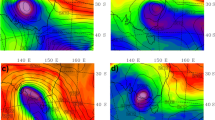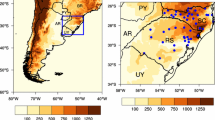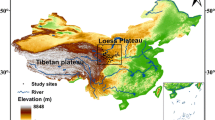Abstract
This study aimed to reveal the temporal statistics, formation mechanisms, suitable land/sea surface (LS/SS) and upper-level atmospheric conditions, and predictability of thundersnow (TSSN) events that occurred between 2000 and 2021 in the Marmara Region with atmospheric stability indexes. Aviation reports from 11 airports were analyzed throughout the period, and no TSSN events were found at four airports. A total of 19 TSSN events were identified, and six events were found in 2015, when the sea-effect snow (SES) mechanisms were observed four times. The majority of TSSN events were of very short duration (0–1 h), and no significant trend was observed in terms of intraday distribution. SES mechanism was observed in 17 of the 19 TSSN events, and the dominance of northern flows was detected at all airports and at the sub-inversion upstream levels. In terms of air-sea interaction, suitable temperature differences between the SS and 850/700 hPa (17 °C and 27 °C on average), and the transfer of heat-moisture fluxes from the SS to the upper-atmosphere were possible in almost all TSSN events. In this way, meteorological parameters were sufficient for the formation and strengthening of the convective layer. In addition, the presence of directional wind shear and the observation of inversion layers restricting convective movements at higher levels instead of near the surface ensured that the moisture requirement, lifting mechanism, and unstable atmospheric conditions required for the formation of TS were provided. The CAPE values were very low for winter TSs. Total Total Index and TQ Index produced the most appropriate results for TSSN prediction.






Source: University of Wyoming 2021)

Similar content being viewed by others
Availability of data and material
Not applicable.
Code availability
Not applicable.
References
Ackerman SA, Knox JA (2002) Meteorology: understanding the atmosphere: Brooks
Adhikari A, Liu C (2019) Geographical distribution of thundersnow events and their properties from GPM Ku-band radar. J Geophy Res Atmos 124(4):2031–2048. https://doi.org/10.1029/2018JD028839
Bech J, Pineda N, Rigo T, Aran M (2013) Remote sensing analysis of a mediterranean thundersnow and low-altitude heavy snowfall event. Atmos Res 123:305–322. https://doi.org/10.1016/j.atmosres.2012.06.021
Carpenter DM (1993) The lake effect of the great lake: overview and forecast problems. Wea Forecast 8:181–193
Cherington M (2001) Lightning injuries in sports: situations to avoid. Sports Med 31(4):301–308. https://doi.org/10.2165/00007256-200131040-00004
Colman BR (1990a) Thunderstorms above frontal surfaces in environments without positive CAPE. Part i: climatology. Mon Wea Rev 118(5):1103–1122
Colman BR (1990) Thunderstorms above frontal surfaces in environments without positive CAPE. Part II: organization and instability mechanisms. Mon Wea Rev 118(5):1123–1144
Crowe C, Market P, Pettegrew B, Melick C, Podzimek J (2006) An investigation of thundersnow and deep snow accumulations. Geophys Res Lett 33(24):L24812. https://doi.org/10.1029/2006GL028214
Curran JT, Pearson AD (1971) Proximity soundings for thunderstorms with snow preprints, seventh Conference on severe local storms. American meteorological society Kansas City, MO. pp 118–119.
Doswell CA III, Evans JS (2003) Proximity sounding analysis for derechos and supercells: an assessment of similarities and differences. Atmos Res 67–68:117–133. https://doi.org/10.1016/S0169-8095(03)00047-4
Dunya (2015) Severe storm affected flights at Sabiha Gokçen Airport. https://www.dunya.com/gundem/siddetli-ruzgar-ucak-seferlerini-de-etkiledi-haberi-268222. Accessed 21 November 2021
Elkins HA (1987) Thunderstorms with snow: a comprehensive, empirical study of their occurrence, development and structure. M. S. Thesis, Saint Louis University, p 79
FGA (2021) Future Generation Aviation: airports in Turkey. http://www.tr.auto-gyro.com/sayfa/ucus-hazirligi/turkiye-havaalanlari.html Accessed 23 November 2021
Fujisaki-Manome A, Fitzpatrick LE, Gronewold AD, Anderson EJ, Lofgren BM, Spence C, Chen J, Shao C, Wright DM, Xıao C (2017) Turbulent heat fluxes during an extreme lake-effect snow event. J Hydrometeorolo 18(12):3145–3163. https://doi.org/10.1175/JHM-D-17-0062.1
Galway JG (1956) The lifted index as a predictor of latent instability. Bull Amer Meteor Soc 43:528–529. https://doi.org/10.1175/1520-0477-37.10.528
GDSAA (2021) General Directorate of State Airports Authority, Republic of Turkey ministry of transport and infrastructure: Airport information. https://www.dhmi.gov.tr/Sayfalar/HavaLimanlari.aspx Accessed 29 November 2021
Gerbush MR, Kristovich DAR, Laird NF (2008) Mesoscale boundary layer and heat flux variations over pack ice-covered Lake Erie. J Appl Meteor Climatol 47(2):668–682. https://doi.org/10.1175/2007JAMC1479.1
Halcomb CE, Market PS (2003) Forcing, instability, and equivalent potential vorticity in a midwestern U.S. convective snowstorm. Meteorol Appl 10:273–280. https://doi.org/10.1017/S1350482703003074
Henry NL (2000) A static stability index for low-topped convection. Wea Forecast 15(2):246–254. https://doi.org/10.1175/1520-0434(2000)015%3c0246:ASSIFL%3e2.0.CO;2
Hjelmfelt MR (1990) Numerical study of the influence of environmental conditions on lake-effect snow-storms on Lake Michigan. Mon Wea Rev 118:138–150. https://doi.org/10.1175/1520-0493(1990)118%3C0138:NSOTIO%3E2.0.CO;2
Holle RL, Cortinas JV, Robbins CC (1998) Winter thunderstorms in the United States. Preprints, 16th Conf. on weather analysis and forecasting, phoenix, AZ, Amer Meteor Soc 298–300
Holroyd EW III (1971) Lake-effect cloud bands as seen from weather satellites. J Atmos Sci 28:1165–1170. https://doi.org/10.1175/1520-0469(1971)028%3c1165:LECBAS%3e2.0.CO;2
IOWA (2021) Environmental mesonet: ASOS-AWOS-METAR data. https://mesonet.agron.iastate.edu/request/download.phtml. Accessed 29 November 2021
Jiusto JE, Kaplan ML (1972) Snowfall from lake-effect storms. Mon Wea Rev 100(1):62–66. https://doi.org/10.1175/1520-0493(1972)100%3c0062:SFLS%3e2.3.CO;2
Kristovich DAR, Laird NF (1998) Observations of widespread lake-effect cloudiness: influences of lake surface temperature and upwind conditions. Wea Forecast 13(3):811–821. https://doi.org/10.1175/15200434(1998)013%3c0811:OOWLEC%3e2.0.CO;2
Kumijan MR, Dierling W (2015) Analysis of thundersnow storms over northern Colorado. Wea Forecast 30(6):1469–1490. https://doi.org/10.1175/WAF-D-15-0007.1
Kunkel KE, Wescott NE, Kristovich DAR (2002) Assessment of potential effects of climate change on heavy lake-effect snowstorms near lake-Erie. J Gt Lakes Res 28:521–536. https://doi.org/10.1016/S0380-1330(02)70603-5
Laird NF, Walsh JE, Kristovich DAR (2003) Model simulations examining the relationship of lake-effect morphology to lake shape, wind direction, and wind speed. Mon Wea Rev 131(9):2102–2111
Laird NF, Kristovich DAR (2004) Comparison of observations with idealized model results for a method to resolve winter lake-effect mesoscale morphology. Mon Wea Rev 132:10931103
Laird NF, Desrochers J, Payer M (2009) Climatology of lake-effect precipitation events over lake Champlain. J Appl Meteorol 48:232–250. https://doi.org/10.1175/2008JAMC1923.1
Lang CE, McDonald JM, Gaudet L, Doeblin D, Jones EA, Laird NF (2018) The influence of a lake-to-lake connection from Lake Huron on the lake-effect snowfall in the vicinity of lake Ontario. J Appl Meteor 57(7):1423–1439. https://doi.org/10.1175/JAMC-D-17-0225.1
Lucas C, Zipser EJ, LeMone MA (1994) Convective available potential energy in the environment of oceanic and continental clouds: correction and comments. J Atmos Sci 51(24):3829–3830. https://doi.org/10.1175/1520-0469(1994)051%3c3829:CAPEIT%3e2.0.CO;2
Market PS, Halcomb CE, Ebert RL (2002) A Climatology of thundersnow events over the contiguous United States. Wea Forecast 17(6):1290–1295. https://doi.org/10.1175/1520-0434(2002)017%3c1290:ACOTEO%3e2.0.CO;2
Market PS, Oravetz AM, Gaede D et al (2006) Proximity soundings of thundersnow in the central United States. J Geophys Res. https://doi.org/10.1029/2006JD007061
Market PS, Ebert-Cripe RL, Bodner M (2007) Case study of a longlived thundersnow event. Nat Weather Dig 31:103–120
Mäkelä A, Saltikoff E, Julkunen J, Juga I, Gregow E, Niemelä S (2013) Cold-season thunderstorms in Finland and their effect on aviation safety. Bull of Amer Meteor Soc 94(6):847–858. https://doi.org/10.1175/BAMS-D-12-00039.1
Markowski P, Richardson Y (2010) Mesoscale meteorology in midlatitudes. Wiley-Blackwell, Chichester, p 407
Miller RC (1972) Notes on the analysis of severe storm forecasting procedures of the air force global weather center AFGWC Tech Rep 200. Air Weather Service, Scott AFB, IL
Munzar J, Franc M (2003) Winter thunderstorms in central Europe in the past and the present. Atmos Res 67–68:501–515. https://doi.org/10.1016/S0169-8095(03)00062-0
Niziol TA (1987) Operational forecasting of lake effect snowfall in western and central New York. Weather Forecast 2(4):310–321. https://doi.org/10.1175/1520-0434(1987)002%3C0310:OFOLES%3E2.0.CO;2
Niziol TA, Snyder W, Waldstreicher J (1995) Winter weather forecasting throughout the eastern United States. Part IV: lake effect snow. Wea Forecast 10:61–77. https://doi.org/10.1175/1520-0434(1995)010%3c0061:WWFTTE%3e2.0.CO;2
NOAA (2021) National Oceanic and Atmospheric Administration: NCEP/NCAR reanalysis II. https://psl.noaa.gov/data/gridded/data.ncep.reanalysis.pressure.html.Accessed 7 November 2021
NWS (2021) National Weather Service: Definition of atmospheric variables, atmospheric stability indicies. https://www.weather.gov/ffc/gloss2. Accessed 7 October 2021
Özdemir ET, Deniz A, Sezen İ, Aslan Z, Yavuz V (2017) Investigation of thunderstorms over Ataturk International Airport (LTBA) Istanbul. Mausam 68(1):175–180
Özdemir ET, Yavuz V, Deniz A, Karan H, Kartal M, Kent S (2019) Squall line over antalya: a case study of the events of 25 October 2014. Weather 74(S1):S1–S6. https://doi.org/10.1002/wea.3459
Özdemir ET (2021) A Case study of a multicell severe convective storm in Ankara, Turkey. Pure Appl Geophys 178:4107–4126. https://doi.org/10.1007/s00024-021-02795-y
Pepler RA, Lamb PJ (1989) Tropospheric static stability and central north American growing season rainfall. Mon Wea Rev 117(6):1156–1180. https://doi.org/10.1175/1520-0493(1989)117%3c1156:TSSACN%3e2.0.CO;2
Pettersen S (1956) Weather analysis and forecasting:, vol II. McGraw-Hill, Weather and Weather Systems, p 266
Reinking RF, Caiazza R, Kropfli RA, Orr BW, Martner BE, Niziol TA, Byrd GP, Penc RS, Zamora RJ, Snider JB, Ballentine RJ, Stamm AJ, Bedford CD, Joe P, Koscielny AJ (1993) The Lake-Ontario winter storms (LOWS) project. Bull Amer Meteor Soc 74(10):1828–1849
Rothrock HJ (1969) An aid in forecasting significant lake snows. Tech Memo WBTM CR-30, National weather service central the region, p 16
Schultz DM (1999) Lake-effect snowstorms in northern utah and western New York with and without lightning. Wea Forecast 14(6):1023–1031. https://doi.org/10.1175/1520-0434(1999)014%3c1023:LESINU%3e2.0.CO;2
Schultz DM, Vavrek RJ (2009) An overview of thundersnow. Weather 64(10):274–277. https://doi.org/10.1002/wea.376
Scott CPJ, Sousounis PJ (2001) The utility of additional soundings for forecasting lake-effect snow in the great lakes region. Wea Forecast 16(4):448–462
Showalter AK (1953) A stability index for forecasting thunderstorms. Bull Amer Meteor Soc 34(6):250–252. https://doi.org/10.1175/1520-0477-34.6.250
Sousounis PJ, Mann GE (2000) Lake-aggregate mesoscale disturbances. Part V: Impacts on lake-effect precipitation. Mon Wea Rev 128(3):728–745
Steenburgh WJ, Halvorson SF, Onton DJ (2000) Climatology of lake-effect snowstorms of the great Salt Lake. Mon Wea Rev 128:709–727. https://doi.org/10.1175/1520-0493(2000)128%3C0709:COLESO%3E2.0.CO;2
Steenburgh WJ, Onton DJ (2001) Multiscale Analysis of the 7 December 1998 great Salt lake-effect Snowstorm. Mon Wea Rev 129(6):1296–1317. https://doi.org/10.1175/1520-0493(2001)129%3c1296:MAOTDG%3e2.0.CO;2
Stuart NA (2001) Multi-dimensional analysis of an extreme thundersnow event during the 30 December 2000 snowstorm. In 18th Conference on Weather Analysis and Forecasting, Fort Lauderdale, FL, Amer Meteor Soc 18:223–226.
TSMS (2021) Turkish State Meteorological Service. http://www.mgm.gov.tr. Accessed 24 December 2021University of Wyoming (2021) Upper-level atmospheric charts. http://weather.uwyo.edu/upperair/sounding.html. Accessed 9 October 2021
Wahiduzzaman M, Ali MA, Luo JJ et al (2022) Effects of convective available potential energy, temperature and humidity on the variability of thunderstorm frequency over Bangladesh. Theor Appl Climatol 147:325–346. https://doi.org/10.1007/s00704-021-03833-4
Weisman ML, Klemp JB (1982) The dependence of numerically simulated convective storms on vertical wind shear and buoyancy. Mon Wea Rev 110:504–520. https://doi.org/10.1175/1520-0493(1982)110%3c0504:TDONSC%3e2.0.CO;2
WHOI (2021) Woods Hole Oceanographic Institute. http://apdrc.soest.hawaii.edu/datadoc/whoioafluxday.php. Accessed 11 March 2021
Wilkinson JM, Wells H, Field PR, Agnew P (2013) Investigation and prediction of helicopter-triggered lightning over the North Sea. Meteor Appl 20(1):94–106. https://doi.org/10.1002/met.1314
Yavuz V, Özdemir ET, Deniz A (2020) Nowcasting of a thunderstorm: the case study of 2 February, 2015 at Istanbul Ataturk International Airport. Mausam 71(1):21–32
Yavuz V, Özen C, Çapraz Ö, Özdemir ET, Deniz A, Akbayır İ, Temur H (2021a) Analysing of atmospheric conditions and their effects on air quality in Istanbul using Sodar and Ceilometer. Environ Sci Pollut Res. https://doi.org/10.1007/s11356-021-16958-w
Yavuz V, Deniz A, Özdemir ET, Kolay O, Karan H (2021b) Classification and analysis of sea-effect snowbands for Danube Sea area in Black Sea. Int J Climatol 41(5):3139–3152. https://doi.org/10.1002/joc.7010
Yavuz V, Deniz A, Özdemir ET (2021c) Analysis of a vortex causing sea-effect snowfall in the western part of the Black Sea: a case study of events that occurred on 30–31 January 2012. Nat Hazards 108:819–846. https://doi.org/10.1007/s11069-021-04707-8
Yavuz V, Deniz A, Özdemir ET, Karan H, Temiz C (2022a) Long-term thunderstorm analysis at Airports in the Marmara region: types and favourable atmospheric conditions. Int J Global Warming (in press)
Yavuz V, Lupo AR, Fox NI, Deniz A (2022b) Meso-scale comparison of non-sea-effect and sea-effect snowfalls, and development of prediction algorithm for megacity Istanbul Airports in Turkey. Atmosphere 13(5):657. https://doi.org/10.3390/atmos13050657
Yavuz V, Lupo AR, Fox NI, Deniz A (2022c) The role of short-wave troughs on the formation and development of sea-effect snowbands in the western Black Sea. Theor Appl Climatol. https://doi.org/10.1007/s00704-022-04071-y
Ye B, Genio ADD, Lo KKW (1998) CAPE variations in the current climate and in a climate change. J Clim 11(8):1997–2015. https://doi.org/10.1175/1520-0442(1998)011%3c1997:CVITHCC%3e2.0.CO;2
Zhang GJ (2003) Diurnal cycle of convection at the ARM SGP site: role of large-scale forcing, surface fluxes, and convective inhibition. 13th ARM science team meeting proceedings, Broomfield
Zhao W, Duan SB (2020) Reconstruction of daytime land surface temperatures under cloud-covered conditions using integrated MODIS/Terra land products and MSG geostationary satellite data. Remote Sens Environ 247:1–15. https://doi.org/10.1016/j.rse.2020.111931
Zook D (2014) When lightning strikes. Ski Area. Manage 53(4):36
Acknowledgements
This work is funded by the Turkish Science Foundation (TUBITAK) with Grant Number 1059B142000051. The authors would like to thank the Turkish State Meteorological Service for the data used in this study.
Funding
The work is funded by the Turkish Science Foundation (TUBITAK) with Grant Number 1059B142000051.
Author information
Authors and Affiliations
Contributions
VY: Conceptualization, Introduction, Methodology, Formal analysis, Writing—Original draft preparation, Writing, Reviewing and Editing. ARL: Conceptualization, Supervision, Writing, Reviewing and Editing. NIF: Conceptualization, Supervision, Writing, Reviewing and Editing. AD: Conceptualization, Supervision, Writing, Reviewing and Editing.
Corresponding author
Ethics declarations
Conflict of interest
The authors have no conflict of interest to declare that are relevant to the content of this article.
Consent for publication
The authors confirm that the study is original and abide within the regulations for publication.
Consent to participate
Not applicable.
Ethical approval
Not applicable.
Additional information
Publisher's Note
Springer Nature remains neutral with regard to jurisdictional claims in published maps and institutional affiliations.
Rights and permissions
About this article
Cite this article
Yavuz, V., Lupo, A.R., Fox, N.I. et al. A long-term analysis of thundersnow events over the Marmara Region, Turkey. Nat Hazards 114, 367–387 (2022). https://doi.org/10.1007/s11069-022-05393-w
Received:
Accepted:
Published:
Issue Date:
DOI: https://doi.org/10.1007/s11069-022-05393-w




